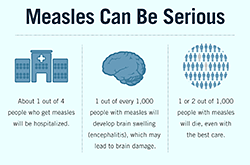Complications of Measles
Español: Complicaciones del sarampión
Complications
Measles can be a serious in all age groups. However, children younger than 5 years of age and adults older than 20 years of age are more likely to suffer from measles complications.
Common Complications
Common measles complications include ear infections and diarrhea.
- Ear infections occur in about one out of every 10 children with measles and can result in permanent hearing loss.
- Diarrhea is reported in less than one out of 10 people with measles.
Severe Complications
Some people may suffer from severe complications, such as pneumonia (infection of the lungs) and encephalitis (swelling of the brain). They may need to be hospitalized and could die.
- As many as one out of every 20 children with measles gets pneumonia, the most common cause of death from measles in young children.
- About one child out of every 1,000 who get measles will develop encephalitis (swelling of the brain) that can lead to convulsions and can leave the child deaf or with intellectual disability.
- For every 1,000 children who get measles, one or two will die from it.
Measles may cause pregnant woman to give birth prematurely, or have a low-birth-weight baby.
The Measles chapter of the Epidemiology and Prevention of Vaccine Preventable Diseases (Pink Book) describes measles complications in more depth.
Long-term Complications
Subacute sclerosing panencephalitis (SSPE) is a very rare, but fatal disease of the central nervous system that results from a measles virus infection acquired earlier in life. SSPE generally develops 7 to 10 years after a person has measles, even though the person seems to have fully recovered from the illness. Since measles was eliminated in 2000, SSPE is rarely reported in the United States.
Among people who contracted measles during the resurgence in the United States in 1989 to 1991, 4 to 11 out of every 100,000 were estimated to be at risk for developing SSPE. The risk of developing SSPE may be higher for a person who gets measles before they are two years of age. For more information, see Subacute sclerosing panencephalitis (SSPE): MedlinePlus Medical Encyclopedia.
References
- Barrero PR, Grippo J, Viegas M, Mistchenko AS. Wild-type Measles Virus in Brain Tissue of Children with Subacute Sclerosing Panencephalitis, Argentina. Emerg Infect Dis. 2003; 9:1333-1336.
- Bellini, W.J., Rota, J.S., Lowe L.E., et al. Subacute Sclerosing Panencephalitis: More Cases of this Fatal Disease are Prevented by Measles Immunization than Previously Recognized. J Infect Dis. 2005;192:1686-1693.
- Bonthius DJ, Stanek N, Grose C. Subacute Sclerosing Panencephalitis, a Measles Complication, in an Internationally Adopted Child. Emerg Infect Dis. 2000. 6:377-381.
- Campbell H, Andrews N, Brown KE and Miller E. Review of the effect of measles vaccination on the epidemiology of SSPE. Int J Epidemiol. 2007;36:1334-1348.
- Centers for Disease Control and Prevention. Subacute Sclerosing Panencephalitis Surveillance–United States. MMWR. 1982. 31:585-8.
- Centers for Disease Control and Prevention. Epidemiology and Prevention of Vaccine-Preventable Diseases. Chapter 10, Measles. 8th Edition, 2004.
- Jin L, Beard S, Brown DWG, Miller E. Characterization of Measles Virus Strains Causing SSPE: A Study of 11 Cases. J of Neurovirol. 2002; 8:335-344.
- Miller C, Farrington CP, Harbert K. The Epidemiology of Subacute Sclerosing Panencephalitis in England and Wales 1970-1989. Int J Epidemiol. 1992; 21:998-1006.
- Page last reviewed: February 13, 2017
- Page last updated: March 3, 2017
- Content source:


 ShareCompartir
ShareCompartir
